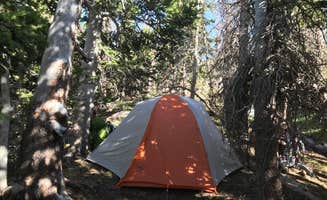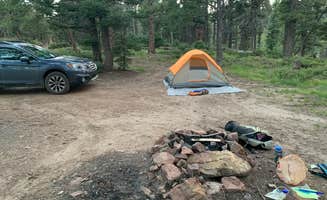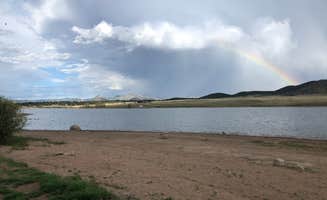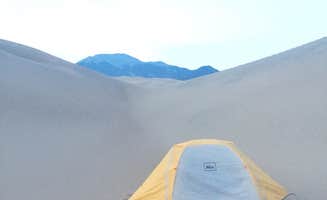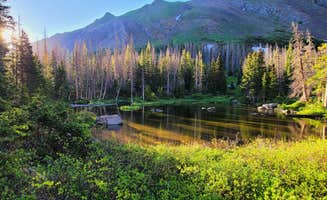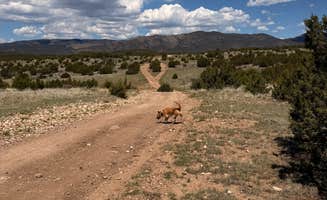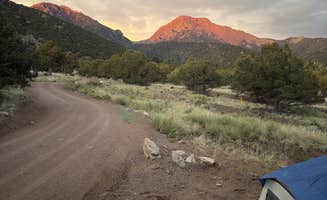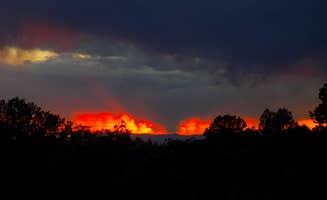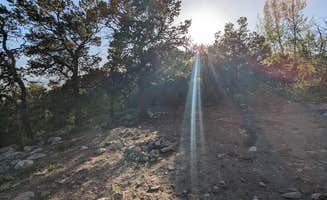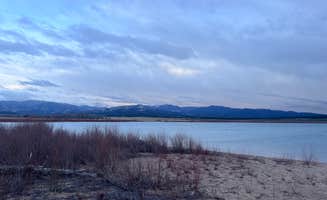Dispersed camping options near Rye, Colorado extend beyond the Sangre de Cristo Mountains into additional public lands managed by the Bureau of Land Management and Colorado State Wildlife Areas. Most sites sit between 7,000-9,000 feet elevation, creating significant temperature fluctuations between day and night even during summer months. Many dispersed camping areas require visitors to navigate steep terrain with loose soil conditions that change dramatically after rainfall.
What to do
Mountain biking access: Sacred White Shell Mountain offers trails suitable for intermediate riders with views of the surrounding valley. "Smooth dirt road with large spots and smaller spots right off the road. Perfect for when all the other nearby campgrounds are full, but make sure you get there before sunset because it will fill up," notes one camper at Sacred White Shell Mountain.
Stargazing opportunities: The dark skies in this region provide exceptional stargazing, particularly at higher elevation sites. At BLM Mt. Blanca Rd. Dispersed, one camper reported: "I saw constellations that I had only heard about. It dipped down to upper forties so bring an extra blanket. And it was windy af."
Hiking to alpine lakes: Several trails lead to high-country lakes within 1-2 hour drives from dispersed camping areas. "Highly recommend Medano Lake for a hike in addition to the dunes," suggests a camper who stayed at Medano Pass Primitive Road.
What campers like
Temperature variations: The dramatic temperature shifts provide comfortable sleeping weather even during hot summer days. "The temperature almost went down to freezing at night in early June, so be prepared with layers for both hot and cold desert conditions," explains a camper who stayed at Great Sand Dunes Dispersed.
Wildlife viewing: Free camping near Rye, Colorado often includes encounters with local wildlife. At Lake Deweese state wildlife area, campers might see various species. "The biggest noise was the free-range cows in the morning making a raucous and using the RV as a back scratcher. They didn't visit every morning but were there several times bright and early," reports a visitor.
Cell service: Unlike many remote areas, several dispersed sites maintain usable cell coverage. "My phone and WiFi (through my phone) worked very well. I have AT&T currently and there was no one here to ask about other carriers," notes a camper at Ophir Creek Road.
What you should know
Wildlife permits required: Several camping areas operate as State Wildlife Areas and require specific permits. "Colorado State wildlife areas (SWA) require a permit that's ~$40 a year, or if you have a year fishing or hunting license you camp for free," explains a visitor to Lake Deweese state wildlife area.
Road conditions: Roads deteriorate quickly at higher elevations, particularly after rainfall. "If you don't have high clearance scout it out before attempting. Lower sites are very open but decent space between locations. The higher you go the better the sites with some piñon and good spacing," advises a camper at BLM Mt. Blanca Rd.
Insect populations: Biting flies and mosquitoes can be intense during warmer months. "There are A TON of flies! Lots of bug spray and loose clothing to avoid those pesky biting flies," warns a camper at BLM Mt. Blanca Rd.
Tips for camping with families
Safety around water: Water features present hazards beyond drowning. "DO NOT let kids or dogs in water, as there is a level red warning for toxic algae," cautions a recent visitor to Lake Deweese state wildlife area.
Dealing with temperature extremes: Prepare for significant temperature fluctuations throughout the day. One camper at The Dunefield notes: "It was much cooler than we thought because of a strong breeze. Highly recommend."
Cacti hazards: Watch for desert plants that can injure children and pets. "Cactuses everywhere too so wear your shoes," warns a camper at BLM Mt. Blanca Rd. Dispersed.
Tips from RVers
Lower elevations for larger rigs: The most accessible sites for RVs remain at lower elevations where roads are better maintained. At Penrose Common Rec Site, "The first few spaces can easily fit a full sized camper trailer but after that I wouldn't suggest going too far."
Water management: No potable water exists at most sites, requiring careful planning. "No amenities at all so pack in and out. The area is about 20-25 minutes to the Great Sand Dunes National Park. We were able to get potable water there (at the dump station) and dump as we were leaving," explains a camper describing nearby BLM areas.
Leveling challenges: Rocky terrain makes leveling difficult at most sites. "The camping areas are very easy to find and are directly off Lake Como Road. Most everyone else needed blocks, but they didn't seem to have much problem leveling," notes a visitor describing free camping near Great Sand Dunes.


